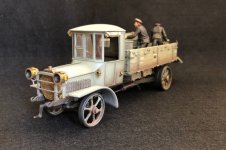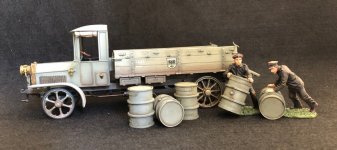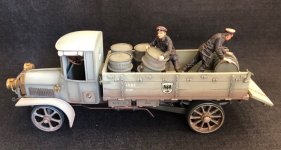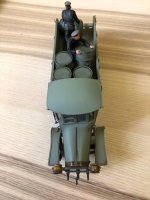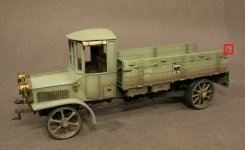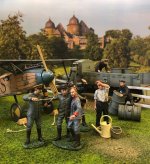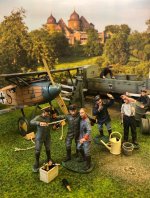NEW RELEASES FOR MARCH 2018
KNIGHTS OF THE SKIES
The First World War spelled the breakthrough as a means of transport for the truck, both for military use and in private enterprise.
Like the United Kingdom, Germany entered the First World War with a "Subsidy" system. Under this system civilian companies were allowed to purchase vehicles at a lower price provided that they would hand them over to the military in case of war. Their number, however, remained too low to fulfill the German Army’s needs in 1914. As a consequence an enormous variety of civilian trucks were impressed into military service when the war started. However, in the coming years of war, this variety mostly vanished, as many trucks were used up in the daily grind and the army could order more unified military trucks. On the average some 25,000 trucks were in German Army service at any single day during the war.
During the war about 40,000 new trucks were manufactured between 1914-1918.
One of the "Subsidy" truck designs that was kept in production throughout the war was made by Daimler Marienfelde (Marienfelde was the location of the Daimler factory). The truck was of modern design and went into production in 1914. It was used extensively wherever the German Army went. Technically it was a 3-ton truck with chain drive, using a 4-cylinder gasoline engine which gave it a maximum speed of some 30 km/h. Over 3,000 of these trucks were built between 1914-18.
Multiple period photos exist showing aircraft being transported on these lorries and towed behind.
Many of these trucks survived the war and were used by civilian companies or the German Reichswehr Army during the twenties and thirties, with pneumatic tires replacing the old solid ones.
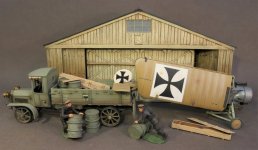
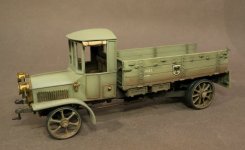
GGC-31
KNIGHTS OF THE SKIES,
DAIMLER MERIENFELDE TRUCK.
(1 pc)
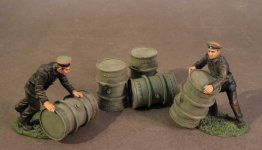
GGC-32
KNIGHTS OF THE SKIES,
GERMAN MECHANICS AND OIL DRUMS.
(5 pcs)
Frank Luke Jr. (May 19, 1897 – September 29, 1918) was an American fighter ace, ranking second among U.S. Army Air Service pilots after Captain Eddie Rickenbacker in number of aerial victories during World War I(Rickenbacker was credited with 26 victories, while Luke's official score was 18). Frank Luke was the first airman to receive the Medal of Honor. Luke Air Force Base, Arizona, a U.S. Air Force pilot training installation since World War II, is named in his honor.
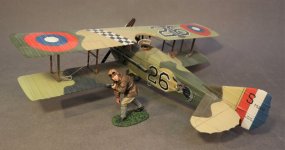
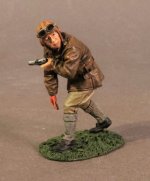
ACE-26P
KNIGHTS OF THE SKIES,
Lt. FRANK LUKE Jr..
(1pc)
Luke's final flight took place during the first phase of the Meuse-Argonne Offensive. On September 28, after achieving his 14th and 15th victories, he landed his SPAD XIII at the French aerodrome at Cicognes where he spent the night, claiming engine trouble. When he returned to the 1st Pursuit Group's base at Rembercourt the next day, he was confronted by Captain Alfred A. Grant, his squadron's commanding officer (C.O.). Despite being under threat of arrest by Grant for being AWOL, Luke took off without authorization and flew to a forward airbase at Verdun, where his sympathetic group commander, Major Hartney, canceled the arrest order and gave Luke tacit approval to continue his balloon hunting. That evening Luke flew to the front to attack three balloons in the vicinity of Dun-sur-Meuse, six miles behind the German lines. He first dropped a message to a nearby U.S. balloon company, alerting them to observe his imminent attacks. Luke shot down the enemy balloons, but was then severely wounded by a single machine gun bullet fired from a hilltop above him, a mile east of the last balloon site he had attacked. Luke landed in a field just west of the small village of Murvaux—after strafing a group of German soldiers on the ground—near the Ruisseau de Bradon, a stream leading to the Meuse River. Although weakened by his wound, he made his way toward the stream, intending to reach the cover of its adjacent underbrush, but finally collapsed some 200 meters from his airplane. Approached by German infantry, Luke drew his Colt Model 1911 pistol and fired a few rounds at his attackers before dying. Reports that a day later his body was found with an empty gun and a bullet hole in his chest, with seven dead Germans in front of him were proven erroneous. According to author Skinner, the fatal bullet, fired from the hilltop machine gun position, had entered near Luke's right shoulder, passed through his body, and exited from his left side
Eddie Rickenbacker said of Luke: "He was the most daring aviator and greatest fighter pilot of the entire war. His life is one of the brightest glories of our Air Service. He went on a rampage and shot down fourteen enemy aircraft, including ten balloons, in eight days. No other ace, even the dreaded Richthofen, had ever come close to that.
**PLEASE CONTACT YOUR LOCAL DEALER FOR FURTHER INFORMATION**
KNIGHTS OF THE SKIES
The First World War spelled the breakthrough as a means of transport for the truck, both for military use and in private enterprise.
Like the United Kingdom, Germany entered the First World War with a "Subsidy" system. Under this system civilian companies were allowed to purchase vehicles at a lower price provided that they would hand them over to the military in case of war. Their number, however, remained too low to fulfill the German Army’s needs in 1914. As a consequence an enormous variety of civilian trucks were impressed into military service when the war started. However, in the coming years of war, this variety mostly vanished, as many trucks were used up in the daily grind and the army could order more unified military trucks. On the average some 25,000 trucks were in German Army service at any single day during the war.
During the war about 40,000 new trucks were manufactured between 1914-1918.
One of the "Subsidy" truck designs that was kept in production throughout the war was made by Daimler Marienfelde (Marienfelde was the location of the Daimler factory). The truck was of modern design and went into production in 1914. It was used extensively wherever the German Army went. Technically it was a 3-ton truck with chain drive, using a 4-cylinder gasoline engine which gave it a maximum speed of some 30 km/h. Over 3,000 of these trucks were built between 1914-18.
Multiple period photos exist showing aircraft being transported on these lorries and towed behind.
Many of these trucks survived the war and were used by civilian companies or the German Reichswehr Army during the twenties and thirties, with pneumatic tires replacing the old solid ones.


GGC-31
KNIGHTS OF THE SKIES,
DAIMLER MERIENFELDE TRUCK.
(1 pc)

GGC-32
KNIGHTS OF THE SKIES,
GERMAN MECHANICS AND OIL DRUMS.
(5 pcs)
Frank Luke Jr. (May 19, 1897 – September 29, 1918) was an American fighter ace, ranking second among U.S. Army Air Service pilots after Captain Eddie Rickenbacker in number of aerial victories during World War I(Rickenbacker was credited with 26 victories, while Luke's official score was 18). Frank Luke was the first airman to receive the Medal of Honor. Luke Air Force Base, Arizona, a U.S. Air Force pilot training installation since World War II, is named in his honor.


ACE-26P
KNIGHTS OF THE SKIES,
Lt. FRANK LUKE Jr..
(1pc)
Luke's final flight took place during the first phase of the Meuse-Argonne Offensive. On September 28, after achieving his 14th and 15th victories, he landed his SPAD XIII at the French aerodrome at Cicognes where he spent the night, claiming engine trouble. When he returned to the 1st Pursuit Group's base at Rembercourt the next day, he was confronted by Captain Alfred A. Grant, his squadron's commanding officer (C.O.). Despite being under threat of arrest by Grant for being AWOL, Luke took off without authorization and flew to a forward airbase at Verdun, where his sympathetic group commander, Major Hartney, canceled the arrest order and gave Luke tacit approval to continue his balloon hunting. That evening Luke flew to the front to attack three balloons in the vicinity of Dun-sur-Meuse, six miles behind the German lines. He first dropped a message to a nearby U.S. balloon company, alerting them to observe his imminent attacks. Luke shot down the enemy balloons, but was then severely wounded by a single machine gun bullet fired from a hilltop above him, a mile east of the last balloon site he had attacked. Luke landed in a field just west of the small village of Murvaux—after strafing a group of German soldiers on the ground—near the Ruisseau de Bradon, a stream leading to the Meuse River. Although weakened by his wound, he made his way toward the stream, intending to reach the cover of its adjacent underbrush, but finally collapsed some 200 meters from his airplane. Approached by German infantry, Luke drew his Colt Model 1911 pistol and fired a few rounds at his attackers before dying. Reports that a day later his body was found with an empty gun and a bullet hole in his chest, with seven dead Germans in front of him were proven erroneous. According to author Skinner, the fatal bullet, fired from the hilltop machine gun position, had entered near Luke's right shoulder, passed through his body, and exited from his left side
Eddie Rickenbacker said of Luke: "He was the most daring aviator and greatest fighter pilot of the entire war. His life is one of the brightest glories of our Air Service. He went on a rampage and shot down fourteen enemy aircraft, including ten balloons, in eight days. No other ace, even the dreaded Richthofen, had ever come close to that.
**PLEASE CONTACT YOUR LOCAL DEALER FOR FURTHER INFORMATION**


